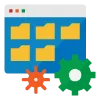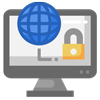
IT Data Cabling and the Evolution
Since the advent of the first computers, the way we transmit data has evolved significantly. From humble beginnings to the current cutting-edge technologies and future trends, IT data cabling has played a pivotal role in the way businesses operate. This article explores the evolution of IT data cabling, its current state, potential future trends, and the question of whether Wi-Fi will replace network cabling.
The Past: Coaxial, Twisted Pair, and Fiber Optic Cabling
The earliest form of IT data cabling was coaxial cabling, a technology inherited from the telephone and television industries. Its robust shielding made it resistant to external interference, but it was bulky and expensive.
In the late 1970s and early 1980s, Ethernet technology popularized the use of twisted pair cabling, a cheaper and more flexible alternative to coaxial cables. Twisted pair cabling came in two types: unshielded twisted pair (UTP) and shielded twisted pair (STP). UTP became the standard for most businesses due to its lower cost and ease of installation.
In the late 20th century, fiber optic cables emerged as a high-speed alternative. Fiber optic cables transmit data as light pulses, offering faster data speeds and greater distances compared to traditional cabling. However, the higher cost and complexity of installation and maintenance made it less common for most business networks.
The Present: Convergence and Structured Cabling
Today's IT data cabling trends are defined by the convergence of technologies and structured cabling. Businesses now use a standardized cabling infrastructure that can carry data, voice, and multimedia across various devices. This structured cabling approach simplifies management, reduces maintenance costs, and allows for flexibility as business needs change.
Copper cabling (Cat 5e, Cat 6, Cat 6a, and Cat 7) and fiber optic cabling are the most common in today's structured cabling systems. The choice depends on the business's specific needs, such as data speeds, distance requirements, and budget. For instance, businesses with larger campuses may use a combination of fiber optic cabling for backbone connections and copper cabling for end-point connections.
The Future: Wireless Networking and Beyond
As we look to the future, the role of IT data cabling in business networks is being redefined by wireless technology. Wi-Fi technology, particularly with the advent of Wi-Fi 6 and the upcoming Wi-Fi 7, offers faster data speeds, more simultaneous connections, and lower latency.
However, does this mean Wi-Fi will replace network cabling? The answer is not as straightforward as one might expect. While Wi-Fi offers convenience and mobility, it still faces challenges in terms of signal interference, security, and consistency of performance compared to wired connections. For these reasons, it's likely that most businesses will continue to use a hybrid approach, combining the flexibility of Wi-Fi with the reliability and speed of wired connections.
Moreover, the growth of Internet of Things (IoT) devices, which require a stable and secure network connection, may necessitate continued use of wired connections, especially for critical infrastructure.
5G and Edge Computing
Another emerging technology that may impact the future of IT data cabling is 5G. With much higher speeds and lower latency than its predecessor, 5G has the potential to revolutionize business networks. It could support a more extensive and reliable wireless network, reducing the need for traditional cabling.
Simultaneously, the rise of edge computing, which pushes data processing closer to the devices where it's needed, could change the dynamics of network design. Instead of centralized servers, businesses might have distributed IT resources, necessitating a new approach to data cabling. In such a scenario, the focus might shift towards creating a robust network infrastructure that supports edge computing, potentially combining wired and wireless technologies.
Li-Fi and Photonics
Looking even further ahead, technologies like Li-Fi (Light Fidelity) and integrated photonics could redefine data transmission. Li-Fi uses light waves instead of radio waves to transmit data, promising speeds up to 100 times faster than Wi-Fi. However, its current limitation is that it requires a direct line of sight to work effectively.
Integrated photonics, the use of light for data transmission within a computer chip or circuit, is still in early development stages but holds significant potential. By replacing electronic circuits with optical ones, we could build computers and servers that can handle data at the speed of light with less heat generation, leading to substantial increases in speed and efficiency.
A Hybrid Future
While we can expect wireless technologies to play an increasingly important role in business IT networks, it is unlikely they will completely replace IT data cabling. The need for reliability, security, and high-speed connections for critical applications will ensure the continued importance of wired connections.
However, the landscape of IT data cabling will undoubtedly evolve. Emerging technologies like 5G, edge computing, Li-Fi, and integrated photonics will shape the future of data transmission, with potential implications for how we design and manage business IT networks. These advancements will offer businesses more options and flexibility in how they manage their IT infrastructure, balancing the need for speed, reliability, and cost-effectiveness.
The key takeaway is that the future of IT data cabling will not be about choosing one technology over another, but rather about effectively integrating different technologies to create a network infrastructure that meets the unique needs of each business. As IT professionals, it's essential to stay abreast of these trends and understand how they can be leveraged to support business objectives.
Here's an overview of common cable types used in IT data cabling and their rated speeds:
- Cat 5e (Category 5 Enhanced): Cat 5e is an enhanced version of the Cat 5 cable. It is designed to reduce crosstalk, i.e., interference from adjacent wires, that can cause data corruption. It can support Ethernet connections up to 1 Gigabit per second (Gbps) at distances up to 100 meters.
- Cat 6 (Category 6): Cat 6 cables provide more bandwidth than Cat 5e and have better immunity from interference. They can support speeds up to 10 Gbps, but the distance is limited to 55 meters at this speed. For distances up to 100 meters, the speed is reduced to 1 Gbps.
- Cat 6a (Category 6 Augmented): Cat 6a cables can support network speeds up to 10 Gbps like Cat 6, but they can maintain this speed for distances up to 100 meters. They also offer improved crosstalk reduction compared to Cat 6.
- Cat 7 (Category 7): Also known as Class F cabling, Cat 7 supports speeds up to 10 Gbps, but it can also support 40 Gbps at distances up to 50 meters, and 100 Gbps for distances up to 15 meters. It uses a modified GigaGate45 connector, which is backward compatible with the RJ45 ethernet ports used by Cat 5e and Cat 6.
When it comes to fiber optic cabling, the speed is not determined by the cable itself, but by the transceivers used at either end of the cable. However, fiber optic cables can support much higher speeds and longer distances than copper cables. For example:
Multi-mode fiber optic cables: These are typically used for short distances and can support speeds up to 100 Gbps for distances up to 150 meters with the right transceivers.
Single-mode fiber optic cables: These are used for long-distance transmissions. They can support 10 Gbps at distances up to 40 kilometers, 40 Gbps and 100 Gbps at distances up to 10 kilometers, and even higher speeds at shorter distances.
It's worth noting that advancements in both copper and fiber optic technologies continue to push these speed and distance limitations. For instance, Cat 8 cables and newer fiber optic transceivers are capable of supporting even higher speeds.










